Copyright ©
Alle Rechte vorbehalten. Rev. 1.0 - 15.06.2003
![]() caissist ad gmx.net
caissist ad gmx.net
![]()
IM Gary Lane...
... on BDG and the Ryder Gambit
... Hans Müller, from the Rooty Hill chess club, Sydney Australia writes "I often play
the Blackmar-Diemer Gambit and especially the Ryder Gambit. I get some fantastic complications
here and the games are great fun. Black can throw a spanner in the works, though and after
1 d4 d5 2 e4 dxe4 3 Nc3 Nf6 4 f3 exf3 5 Qxf3 Qxd4 6 Be3 Qg4 7 Qf2. Black's strongest reply seems
to be 7...e5, do you have a suggestion how White can best continue the attack?"
There will be players who have never heard of this romantic, swashbuckling opening so there is a
need for some background information. Personally, I have always taken an interest in the tricky
opening, which is very popular at club level. Indeed, I have even written a book on it so I know
of its vast appeal to those who prefer gambits. It initially became popular when the American
player Armand Blackmar (1826-1888) popularised the continuation 1 d4 d5 2 e4 dxe4 3 f3 by
playing it with success. He achieved increased status with a contribution to the 1884 edition of
Cook's Synopsis of Chess Openings in a section called "American Inventions in the Chess
Openings". The gambit was later refined by the German master Emil Diemer (1908-1990) who
proposed 3 Nc3 followed by 4 f3. Nowadays, it is fairly unusual for White to meet 4...exf3 with
5 Qxf3 entering the Ryder Gambit. Admittedly, it has produced some marvellous attacking games but
for example in this age of computers there are few correspondence players who fall for the
Opening Lanes obvious tactics. Here is the main reason why White carries on playing such an
outrageous gambit.
Stefan Paschman - Kurschat Correspondence 1986
1 d4 d5 2 e4 dxe4 3 Nc3 Nf6 4 f3 exf3
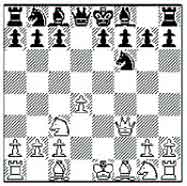
5 Qxf3... (See Diagram)
The starting point of the Ryder Gambit.
5...Qxd4 6 Be3 Qb4 7 0-0-0 Bg4?
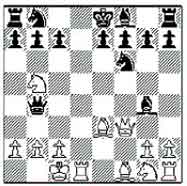
8 Nb5!... (See Diagram)
Do not adjust your chess set because this astounding move has won numerous games. It
first appeared in the game Diemer-Halosar, Baden-Baden 1934.
8...Nbd7 9 Qxb7 Rb8 10 Qxb8+ Nxb8 11 Nxc7 mate 1-0.
This example confirms Hans' thoughts that 7...e5 gives White a difficult task
Lagland - Roos Correspondence 1968
1 d4 d5 2 e4 dxe4 3 Nc3 Nf6 4 f3 exf3 5 Qxf3 Qxd4
Instead Todor - Deak, Bratislava 2000, played it safe with 5...e6 and after 6 Bd3 Be7
7 Nge2 Nbd7 8 0-0 0-0 9 Bg5 c5 10 Ne4 Nxe4 11 Qxe4... when White didn't have enough
compensation for the pawn although the game was eventually drawn. There is also not much
encouragement for White judging from the game Ali - Asylguzhin, Abu Dhabi 1999, which continued
5...c6 6 Bd3 Qxd4 7 Be3 Qb4 8 Nge2 Bg4 9 Qf1 Bxe2 10 Kxe2 Nbd7 11 a3 Qg4+ 12 Kd2 Ne5
13 Bf5 Nc4+ 0-1. 6 Be3 Qg4 7 Qf2 e5 Black stakes a claim for control of the centre.
The pressure direct from the opening can sometimes help Black to go drastically wrong:
7...Nc6 8 h3 Qb4 9 0-0-0 e6 10 Nb5 Nd5? 11 Rxd5... wins, T. Purser - J. Shirley, Ramstein
rapidplay 1979 and 7...Bf5 8 h3 Qg6 9 0-0-0 e5 10 Nf3 Nbd7? 11 Nh4... T. Purser - D.
Bratcher, Correspondence 1978. 8 a3 Bd6 9 Nf3 Qf5 10 Bd3... Or 10 0-0-0 Ng4 11 Qe1 Nxe3
12 Qxe3 Nc6 13 Nb5 Qd7 and the extra material ensures Black's advantage. 10...e4 11 Nxe4 Nxe4
12 Qh4 Qa5+ Black avoids the pin and is already better. It might be of interest that this
game is given as having been played in 1980 according to some books. However, it was played in
the First BDG World Correspondence Championship where all games had to play the opening. I can
only guess that the postal service was good enough to avoid a twelve-year game! 13 b4 Bxb4+
14 Kf1 Nd2+ 15 Nxd2 Bxd2 16 Qe4+ Be6 In a dream White can hope for the continuation
16...Kf8 17 Bxd2 Qxd2 18 Re1 Be6 19 Qxb7 Qf4+ 20 Kg1 Qd4+ 21 Kf1 Bd5?? 22 Qc8 mate.
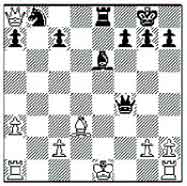
17 Bxd2 Qxd2 18 Qxb7 Qf4+ 19 Ke1 0-0 20 Qxa8 Re8 0-1 (See Diagram)
A classy finish and White resigned in view of the threat of a discovered check on the e-file.
I think the best way to handle the opening is to play 5 Nxf3. For the sake of a pawn White has a
half-open f-file for his rook when he castles kingside and has a lead in development. Of course,
it is debatable whether it is enough compensation for a pawn but it does promise to help create
some brilliant attacking games. The recent chess Olympiad demonstrated that occasionally it is
seen at the premier international events.
Hasan Abbasifar - Samir Mohammad Istanbul OL 2000
1 d4 Nf6 2 f3... A peculiar move-order but it soon transposes to the Blackmar-Diemer.
2...d5 3 e4 dxe4 4 Nc3 exf3
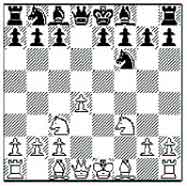
8 Nxf3... (See Diagram)
5...Bg4 The king's Knight usually features in White's attack so it makes sense to pin it.
This line is called The Teichmann Defence.
6 h3 Bh5 7 g4 Bg6 8 Ne5 e6 9 Bg2 c6
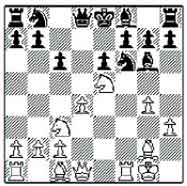
10 O-O... (See Diagram)
10 Bg5 should also be considered. 10...Be7 It is not often that a grandmaster essays the
gambit so it is worth noting that Velimirovic - Andrijevic, Yugoslav Ch 1984, continued
10...Bd6 11 Qe2 Qb6 12 Nc4
Qc7 13 Bf3 h6 14 Be3 Nbd7 15 d5 0-0 16 dxe6 fxe6 17 Bxb6! Bg3 18 Bg5 Ra8 19 Ne4 Nd5
20 Nxg3 Qxg3+ 21 Bg2 and White had the brighter prospects. 11 h4 Nfd7? Black was probably
unfamiliar with the opening and goes astray. Sosa Trani - A. Murillo, San Salvador 1998, saw the
superior 11... Nbd7 when White self-destructed after 12 h5? (12 Nxd7 Qxd7 13 h5? Bxc2 14 Qxc2 Qxd4+
15 Qf2 Qxg4 and Black has too many pawns for the piece) 12...Nxe5 13 dxe5 Bc5+ 14 Kh2 Qxd1
15 Rxd1 Nxg4+ 16 Kg3 Bxh5 17 Kh4 g6 with a bizarre looking position which is hugely in Black's
favour. 12 Nxd7 Nxd7 13 h5... The bishop is trapped and although Black resists White is
always on course to victory. The game concluded: 13...Qc7 14 hxg6 hxg6 15 Bf4 e5 16 Bg3 Qb6
17 Bf2 Qc7 18 Re1 0-0-0 19 dxe5 Nxe5 20 Qe2 f6 21 Bxa7 Qa5 22 Be3 Rh4 23 Rad1 g5 24 Rxd8+ Bxd8
25 Ne4 Rxg4 26 Rd1 Bb6 27 Nf2 Rh4 28 a3 g4 29 Kf1 Bxe3 30 Qxe3 Qb5+ 31 Nd3 Rh8 32 a4 Qc4
33 Qe2 Re8 34 b3 Qc3 35 Nxe5 Rxe5 36 Qxg4+ f5 37 Qd4 Qxd4 38 Rxd4 Kc7 39 Kf2 g5 40 Bf1 1-0 ...
Gary Lane
Copyright © 2000 ChessCafe.com, All Rights Reserved.